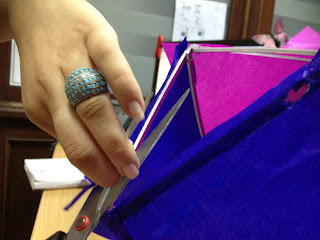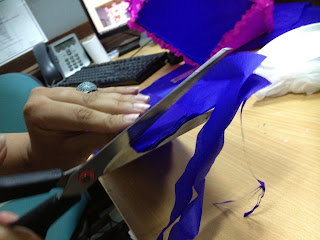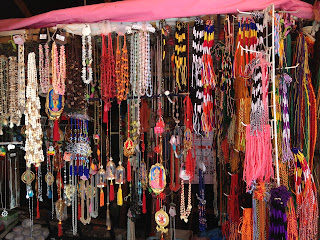...And I say,
It's all right
--------------------
I've become obsessed with the setting sun. Hard not to be with magical moments like these seen all year round!
Monday, May 28, 2012
Wednesday, May 16, 2012
Wish upon a star
The view of the sunset at Negombo Beach. Notice the first star making its shining appearance amidst the glowing orange rays of the setting sun.
Sunday, May 6, 2012
Friday, May 4, 2012
How to make a Vesak Lantern
Gearing up for the weekend’s celebrations, I thought it would be fitting to make a Vesak Lantern for our office cubicle. This was my first attempt at making one, although I must admit I did cheat a tad bit here and there in order to speed up the process. I will now share an easy, step by step guide on how to make a Vesak Lantern.
Below is a list of materials that you will need:
24/25 Strips of bamboo
Thread
Thin tissue paper/ crepe paper
A pair of scissors
Glue/ Paappa (traditional glue made out of plain baking flour and water)
Making the frame
Alright alright, I didn’t make the frame- I bought it off the roadside. But if you wish, you can make one on your own using bamboo sticks (as they are easily bendable) that are cut thin to around 0.5 inch/ 1 cm in diameter. Each stick should measure roughly around 15cms in length making it a manageable size to start off with. Lanterns range in shape and size from simple rectangles or prisms to highly elaborate structures.
All you need to do is take your thin strips of bamboo and tie them tight together with some sturdy thread to form the shape you desire. Let your imagination run wild and come up a whimsically, unique design! (Unlike me)
Making Paappa
This disgustingly gloopy stuff is thoroughly fun to play around with! All you need to do is mix baking flour and water and heat it over the fire until it becomes suitably gooey. Why paappa over glue? The thick paste aids in handling the thin Tissue paper that could easily tear when using glue.
Decorating the frame
Easily the most fun part! Traditionally white tissue paper was used; however you can jazz it up by using various bright colours just like I did. Try not to stick to one colour!
Step 1: Trace the outline of the frame onto the paper leaving about a 1cm leeway, which can be trimmed off later.
Step 2: Apply the thick paste onto the frame and slowly place the cut piece of crepe paper onto the bamboo.
Step 3: Let the lantern dry out and then slowly trim away the excess tissue paper off the edges.
Step 4: Cut thin long strips of paper.
Step 5: Apply paappa to the edges of the lantern and then slowly scallop the thin strips of paper over, neatening out the entire look.
The final step: making tentacles for the lantern!
Step 6: Fold a long strip of paper up several times. Instead of cutting clear through the folded paper, leave some room at the top, and nip the folded part many times to create thin strips. Afterward gently shake the folded paper out and paste the tentacles onto the insides of the lantern!
Voila! You’re done!
Below is a list of materials that you will need:
24/25 Strips of bamboo
Thread
Thin tissue paper/ crepe paper
A pair of scissors
Glue/ Paappa (traditional glue made out of plain baking flour and water)
Making the frame
Alright alright, I didn’t make the frame- I bought it off the roadside. But if you wish, you can make one on your own using bamboo sticks (as they are easily bendable) that are cut thin to around 0.5 inch/ 1 cm in diameter. Each stick should measure roughly around 15cms in length making it a manageable size to start off with. Lanterns range in shape and size from simple rectangles or prisms to highly elaborate structures.
All you need to do is take your thin strips of bamboo and tie them tight together with some sturdy thread to form the shape you desire. Let your imagination run wild and come up a whimsically, unique design! (Unlike me)
Making Paappa
This disgustingly gloopy stuff is thoroughly fun to play around with! All you need to do is mix baking flour and water and heat it over the fire until it becomes suitably gooey. Why paappa over glue? The thick paste aids in handling the thin Tissue paper that could easily tear when using glue.
Decorating the frame
Easily the most fun part! Traditionally white tissue paper was used; however you can jazz it up by using various bright colours just like I did. Try not to stick to one colour!
Step 1: Trace the outline of the frame onto the paper leaving about a 1cm leeway, which can be trimmed off later.
Step 2: Apply the thick paste onto the frame and slowly place the cut piece of crepe paper onto the bamboo.
Step 3: Let the lantern dry out and then slowly trim away the excess tissue paper off the edges.
Step 4: Cut thin long strips of paper.
Step 5: Apply paappa to the edges of the lantern and then slowly scallop the thin strips of paper over, neatening out the entire look.
The final step: making tentacles for the lantern!
Step 6: Fold a long strip of paper up several times. Instead of cutting clear through the folded paper, leave some room at the top, and nip the folded part many times to create thin strips. Afterward gently shake the folded paper out and paste the tentacles onto the insides of the lantern!
Voila! You’re done!
Thursday, May 3, 2012
Jambu
Yes we Lankan's love our spicy food! We will even resort to eating Jambu's (an exotic fruit found mainly in South East Asia) with chilli powder and salt! What a scrumptious snack! Hooray for Jambu season :)
Wednesday, May 2, 2012
Koneswaram Kovil, Trincomalee
Considered one of the most important religious monuments in Sri Lanka, the Koneswaram Kovil (also known as Tirukonamamalai Konesar Kovil or the Temple of the Thousand Pillars) is perched atop a rocky promontory, Swami Rock, overlooking the harbor of Trincomalee. The kovil’s primary deity is the Hindu deity Shiva, who is the Destroyer or Transformer amongst the Divine Hindu trinity. This kovil traces its roots back to as far as the 3rd century.
Over the years the temple was restored by many Sri Lankan Kings as well as Chola invaders of South India, who left their own architectural mark, creating an eclectic and unique religious monument. However the kovil was completely destroyed by the Portuguese when invading Fort Frederick, between the years 1622 and 1624. Evidence suggests that the temple was pushed over Swami Rock into the plummeting depths of the Indian Ocean below. Ancient ruins have been unearthed from underwater by famous science fiction author Arthur C Clarke, the most important find being the lingam, believed to be Swayambhu.
When my friend informed me that we would be making a day trip to Trincomalee, I insisted we visit the temple. Walking up the winding path that leads up to the Koneswaram Kovil, you are greeted with a variety of stalls selling everything from statues of Hindu deities, fresh fruit to quench your thirst and local sweets to munch on. We take off our shoes near the gate and climb up the steps leading to the temple. A massive golden statue of Shiva which was recently erected stands tall against the blue sky. I stand at the foot of the statue feeling rather overwhelmed by its size.
I am greeted by the soothing scent of incense as I walk into the temple, which is scattered with both worshippers and tourists just like me. Intricate statues of numerous Hindu deities dance across the walls of the kovil, treating the eye to an explosion of vivid colour. Legend has it that Lord Ravana (from the popular Indian epic of the Ramayana) worshipped Shiva at this very temple. As he was leaving the temple Ravana dropped his sword and so ‘Ravana Cleft’ was formed. Although I am uncertain of the accuracy of this legend, I can attest to the fact that I felt a calming presence within the safe walls of temple and the surrounding compound. I might not be Hindu, but I was certain a higher power was within our midst.
In the Shaiva tradition of Hinduism, Shiva is considered the Supreme God, whilst all other deities are lower manifestations of Shiva. According to Shaivism, Shiva has five important works including being the creator, preserver, destroyer whilst also concealing and revealing prophecies.
Wandering through the temple complex I marvel over the hands that created the complex statues and artwork that adorn the walls and at how wonderfully most of these ancient sculptures have been preserved over the decades. I can only imagine the havoc that was caused when the entire temple was invaded and destroyed. Today the kovil stands majestically, overlooking the glistening ocean. One can’t help but be enthralled by the mystical element that is associated with the history of the temple, including prophesies that have been discovered and revealed, along with all the secrets that it safely conceals.
Entrance to Fort Frederick
Colourful stalls lining the streets including a stall that sold various religious posters.
Ravanas Cleft
Golden statue of Shiva
Entrance to the kovil
The mystical Lord Ravana
Over the years the temple was restored by many Sri Lankan Kings as well as Chola invaders of South India, who left their own architectural mark, creating an eclectic and unique religious monument. However the kovil was completely destroyed by the Portuguese when invading Fort Frederick, between the years 1622 and 1624. Evidence suggests that the temple was pushed over Swami Rock into the plummeting depths of the Indian Ocean below. Ancient ruins have been unearthed from underwater by famous science fiction author Arthur C Clarke, the most important find being the lingam, believed to be Swayambhu.
When my friend informed me that we would be making a day trip to Trincomalee, I insisted we visit the temple. Walking up the winding path that leads up to the Koneswaram Kovil, you are greeted with a variety of stalls selling everything from statues of Hindu deities, fresh fruit to quench your thirst and local sweets to munch on. We take off our shoes near the gate and climb up the steps leading to the temple. A massive golden statue of Shiva which was recently erected stands tall against the blue sky. I stand at the foot of the statue feeling rather overwhelmed by its size.
I am greeted by the soothing scent of incense as I walk into the temple, which is scattered with both worshippers and tourists just like me. Intricate statues of numerous Hindu deities dance across the walls of the kovil, treating the eye to an explosion of vivid colour. Legend has it that Lord Ravana (from the popular Indian epic of the Ramayana) worshipped Shiva at this very temple. As he was leaving the temple Ravana dropped his sword and so ‘Ravana Cleft’ was formed. Although I am uncertain of the accuracy of this legend, I can attest to the fact that I felt a calming presence within the safe walls of temple and the surrounding compound. I might not be Hindu, but I was certain a higher power was within our midst.
In the Shaiva tradition of Hinduism, Shiva is considered the Supreme God, whilst all other deities are lower manifestations of Shiva. According to Shaivism, Shiva has five important works including being the creator, preserver, destroyer whilst also concealing and revealing prophecies.
Wandering through the temple complex I marvel over the hands that created the complex statues and artwork that adorn the walls and at how wonderfully most of these ancient sculptures have been preserved over the decades. I can only imagine the havoc that was caused when the entire temple was invaded and destroyed. Today the kovil stands majestically, overlooking the glistening ocean. One can’t help but be enthralled by the mystical element that is associated with the history of the temple, including prophesies that have been discovered and revealed, along with all the secrets that it safely conceals.
Entrance to Fort Frederick
Colourful stalls lining the streets including a stall that sold various religious posters.
Ravanas Cleft
Golden statue of Shiva
Entrance to the kovil
The mystical Lord Ravana
Subscribe to:
Comments (Atom)


























